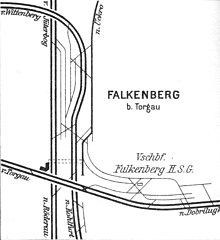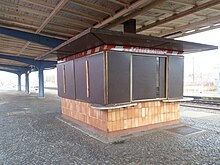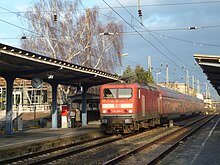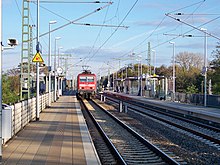Falkenberg (Elster) station
| Falkenberg (Elster) | |
|---|---|
|
View from the upper to the lower part of the station
|
|
| Data | |
| Location in the network | Crossing station |
| Design | Tower station |
| Platform tracks | 6, formerly 8 |
| abbreviation | LF |
| IBNR | 8010103 |
| Price range | 3 |
| Profile on Bahnhof.de | Falkenberg__Elster_ |
| location | |
| City / municipality | Falkenberg / Elster |
| country | Brandenburg |
| Country | Germany |
| Coordinates | 51 ° 35 ′ 0 ″ N , 13 ° 14 ′ 51 ″ E |
| Railway lines | |
|
|
| Railway stations in Brandenburg | |
The Falkenberg (Elster) train station is one of the largest train stations in the state of Brandenburg . It is located in the town of Falkenberg / Elster in the south of the country. Railways run from the station in seven directions. It is built as a tower train station, with the routes on both levels being linked by several connecting curves. There are large shunting systems in both the upper and lower sections of the station . At times Falkenberg was considered the fifth largest marshalling yard in the GDR. These systems have only been partially in use since the 1990s.
A large station building at the station, built in 1882, was destroyed in World War II; a restaurant building that was built during the GDR era was significantly rebuilt after 2010 and is now used as a reception building. A number of buildings in and around the station are listed buildings.
Location and name
Most of the station is in the town of Falkenberg / Elster in the Elbe-Elster district, not far from the state borders with Saxony and Saxony-Anhalt . Originally the station was called Falkenberg (near Torgau) , in 1937 it was given its current name. While the city is now Falkenberg / Elster (with a slash), the river name appears in the station name in brackets. The address is Bahnhofstr. 8, 04895 Falkenberg .
The station building is located at kilometer 111.9 of the Jüterbog – Röderau railway line running in north-south direction , at kilometer 148.2 of the south-east to north-west route from Kohlfurt (now Węgliniec ) to Roßlau and at kilometer 95.0 of the west East route Halle – Cottbus . The latter leads through the upper station of Falkenberg, the others through the lower one. The Lower Lusatian Railway , which leads to the northeast, also begins in the lower station .
Extensive shunting facilities in both the lower and upper sections of the station extend over several kilometers. The eastern part of the upper station extends to the area of the city of Uebigau-Wahrenbrück .
The center of the city of Falkenberg is west of the railway line from Berlin and north of the line from Halle. The original village center with the manor was about 400 meters from the train station.
history
railway station
The first years
The Berlin-Anhaltische Eisenbahn-Gesellschaft (BAE) opened its line from Berlin to Köthen (then Cöthen ) in 1841 . Right from the start, she planned another route that would connect Berlin with Leipzig and Dresden. The cities of Herzberg , Uebigau and Liebenwerda had stubbornly opposed direct contact with their cities by rail. So a more westerly route was chosen that touched the small manor village of Falkenberg. In addition, the straight route chosen was the shortest and cheapest option. After the section from Jüterbog to Herzberg had already been completed in July 1848 (where the station was built well away from the city), the subsequent section to Röderau and with it the Falkenberg station went into operation on October 1, 1848. Falkenberg received a small stopping point, with a station master, a telegraph operator and two switchmen and two shunters.
On December 1, 1871, the line from Falkenberg to Cottbus of the Halle-Sorau-Gubener Railway (HSGE) went into operation. At first the trains stopped in the lower, the old part of the station. On May 1, 1872, the line from Falkenberg west to Eilenburg was opened and Falkenberg became the tower station. On June 30, 1872, continuous traffic to Halle was started and in the same year the Oberlausitzer Eisenbahn-Gesellschaft started building the line from Kohlfurt to Falkenberg. Its opening took place on June 1st, 1874, followed by the extension to Wittenberg on October 15th, 1875 with a connection to the railway lines to Halle and Dessau. In 1878, BAE also took over the management of the Oberlausitzer-Eisenbahn-Gesellschaft line. Traffic on all three routes developed very briskly in the following years, so that Falkenberg became an important rail hub. In 1882 the station received a new, larger station building at the intersection of the upper and lower lines. In the same year, the Prussian state took over management of the BAE routes, and two years later also of the HSGE. Nevertheless, the names Halle-Sorauer Bahnhof for the upper and Berlin-Anhalter Bahnhof for the lower part of the station persisted for a long time.
The Erfurt State Railway Directorate, which was responsible at the time, combined the two machine stations of the BAE and HSGE, and since 1887 they have been referred to as the workshop . The future depot emerged from it.
Expansion after 1890
At the end of the 19th century, traffic around Falkenberg increased significantly. After major capacity bottlenecks occurred on the three main railway lines, they were expanded to double-track between 1896 and 1912. The station facilities with the marshalling yards and workshops were also expanded. In 1895 a new water tower was built, and in 1908 another locomotive shed went into operation in the lower station. As the last of the Falkenberg-touching railway lines, the private Niederlausitz railway to Uckro began operations on March 15, 1898 .
In a train accident in the summer of 1934, a freight train crashed into another in the lower part of the station and the vehicles pushed off the track collided with an oncoming train. One person was killed.
In 1936 the Wehrmacht opened the Alt-Lönnewitz air base in Alt- Lönnewitz, southwest of Falkenberg . A connecting railway led to him from the lower part of the station, which was used to transport materials and to transport the employees of the airport.
In 1939, the station comprised 20 kilometers of main and 93 kilometers of secondary tracks with 324 points. This included 20 signal boxes and three locomotive sheds each on the upper and lower sections of the station. In the wagon exit, up to 4,000 freight wagons per day were transported from the upper and 2,400 from the lower part of the station. There were connecting railways to the airfield with a branch connection to a substation and to a branch of the Kornhaus Torgau cooperative based in Falkenberg.
During the Second World War , construction work began to expand the line towards Jüterbog with multiple tracks, but was not completed. Some embankments have been preserved. The work was largely carried out with the use of forced labor and prisoners of war.
Because of the strategic importance of the train station with its marshalling facilities and the nearby airfield, Falkenberg was the target of Allied bombing raids several times during World War II. The heaviest of these attacks occurred in April 1945. On April 18, the station building and the crossing structure as well as a number of buildings in the area were completely destroyed. After radio reports had announced further attacks for the following day with the aim of completely destroying the Falkenberg railway junction, bombing attacks mainly hit the lower station and destroyed a number of facilities, including the depot.
After the Second World War
A few days after the end of the war, the station commander Brashenko, who was deployed by the Soviet troops on May 15, 1945, ordered the reconstruction of the strategically important railway facilities. In the following months, the railway lines starting from Falkenberg were gradually put back into operation, initially provisionally. It was not until 1948 that all of the tracks could be used again. However, the second track was dismantled on all previously double-track lines.
In the GDR era, the station was expanded further and comprised 160 kilometers of track systems and 377 switches. In addition to the north-east connecting curve from the lower to the upper part of the station, which had existed since the 19th century, connecting curves were created southeast of the intersection, which enabled direct journeys from the west to the lower station and towards Elsterwerda without having to change the direction of travel in the upper marshalling yard. With more than 500 employees, the depot became one of the largest in the GDR. In the 1970s and 1980s, around 5,000 wagons leaving Falkenberg were transported daily. The routes Wegliniec – Roßlau, Halle – Cottbus and Falkenberg – Röderau were expanded to double-track again, beginning around 1970. The Falkenberg – Röderau section was the last, it was only completed in the mid-1980s. The Jüterbog – Falkenberg section remained single-track, although the reinstallation of the second track was largely taken into account.
The station was also important for national defense. For soldiers of the Soviet Army passing through, freight tracks were provisionally provided with platforms so that they could use washing facilities and other options for taking breaks on the station premises. In 1972 a new Mitropa restaurant building went into operation.
On September 27, 1986, the first passenger train hauled by an electric locomotive from the direction of Lutherstadt Wittenberg reached Falkenberg station, and on December 13 of the same year, electrical operation in the direction of Riesa was started. In October 1987 the route followed in the direction of Ruhland . The remaining three main railway branches in the direction of Jüterbog , Torgau and Finsterwalde were electrified in 1989. In connection with the electrification of the Halle – Cottbus line, the connecting arches were also given contact line systems. The station and Bw Falkenberg belonged to the area of responsibility of the Reich Railway Directorate Halle .
After 1990, the importance of the station in freight transport decreased significantly due to the decline in industrial production in the region and the shift of traffic to the road. Since 1991, the number of vehicles in the depot had decreased more and more until the plant was connected to the Lutherstadt Wittenberg depot in 1994 . In 1998 the plant was converted into a deployment site for the Leipzig-Engelsdorf depot and a little later into a purely personnel deployment center without vehicle stationing.
In 2010/11, the passenger platforms in the upper part of the station were rebuilt and the railway facilities were redesigned. The third platform track was omitted. The former Mitropa building was completely rebuilt. Parts of the upper marshalling yard with interlockings 5, 10 and 11 were taken over in 2011 by BLG AutoRail , which uses it as a “hub for car transport by rail”, especially for car imports from the Czech Republic and Slovakia. BLG RailTec GmbH has been the operator of the upper station since April 2017 . The BLG RailTec systems are only connected to the rest of the network on the west side. The signal box 5 went back into operation, the former signal box areas 10 and 11 became manual switch areas. The contact line above the BLG systems was completely dismantled.
environment
The town of Falkenberg is decisively shaped by the railway. In the first few years of the station, Falkenberg was only an en-route station, the place developed little during this time. Immediately before the construction of the railway, Falkenberg had 350 inhabitants, at the time the east-west line opened in the year it was 405. After the east-west line was built and later the line from Wittenberg to Kohlfurt, Falkenberg became a railway junction. The village grew considerably. A number of railroad workers settled in the city. The area between the train station and the old village center was gradually built on. In 1888 the post office opened next to the reception building.
At the end of the 19th century, the expanding tracks became more and more of a traffic obstacle. Instead of the level crossing on Uebigauer Strasse north of the platforms of the lower station, an overpass was built over the tracks in 1896.
From 1897 onwards, with the help of a loan, a cooperative built tenement-like houses in several streets to the west of the train station, which included stables, some garden land and communal laundry rooms. This area is now a monument area as the Falkenberg railway settlement. In 1912 the manor came into the possession of the community, which meant that new building areas could be designated, especially east of the railway. In the 1920s, more apartments were built; with 4850 inhabitants, Falkenberg was the largest town in the then Liebenwerda district in 1925.
In 1962, the town, which had around 7000 inhabitants at that time, was granted city rights. In the city arms, among other things, an impeller is shown as a symbol of the railway.
Plant and buildings
Reception building
Shortly after the line was completed, Falkenberg received a small station building on the west side of the Anhalter Bahn tracks. After completing the other two main railway lines, a large reception building was built in the angle between the east-west and north-south lines. The building was destroyed in the Second World War. The original station building then served as a reception building again. In 1985 the house was significantly rebuilt and its exterior shape changed significantly. It later served as an office building. The building is now empty, and in December 2013 it was sold at a real estate auction.
In the 1970s, a new building for a Mitropa restaurant was built south of it . After 1990 the restaurant building was closed, after 2000 it was temporarily partially used by a kiosk and in 2010 it was completely rebuilt. In 2011 the renewed building was inaugurated, which again houses a restaurant and a ticket sales point. Before the renovation, a small building on the platform to the north of it had been used for ticket sales.
Platforms
The lower part of the station has five platform tracks, track 1 on the main platform, the others (tracks 2 and 3 as well as 4 and 5) on two central platforms . The eastern track 5, previously served mainly by the trains of the Niederlausitzer Eisenbahn , is no longer used. At the southern ends of the platform, stairs lead to the upper platforms. The lower platforms were connected by a pedestrian tunnel. In the summer of 2012, the tunnel was closed and backfilled, travelers between the various lower platforms have to use the upper platforms.
In the upper part of the station there are two outer platforms with the numbers 6 and 7. Up until the renovation after 2000 there were three platform tracks, next to track 6 in about the current location, tracks 7 and 8 were on an island platform.
Track systems
In the area of the station, the electrified main lines Jüterbog - Röderau and (Węgliniec–) Horka Grenz - Roßlau (both in the lower station) and Halle - Cottbus - Guben (upper station) cross. The Niederlausitzer Eisenbahn , a branch line to the northeast , which was later shut down, begins in the station . The industrial connection of the former sand-lime brick works is served; to simplify matters, the track in the area of the Schwarzer Weg crossing was swiveled to the main track of the 6207 line . The old main track of route 6826 to Beeskow led past the eastern edge of the lower freight station and around the roundhouse of the depot. It is out of order and tied on both sides.
Several connecting curves in the north-east and south-east of the station allow journeys between the two levels. The route from Röderau is not directly linked to the upper tracks.
The line from Wittenberg crosses the line from Jüterbog about two kilometers north of the passenger station. The lower marshalling yard is located between the two lines. The upper marshalling yard is located east of the passenger station on the line towards Cottbus. The lower station is designed as a one-sided, the upper one as a two-sided marshalling yard.
Monument protection
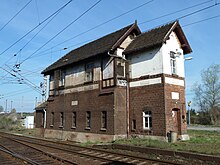
A number of buildings at the station are listed as "Turmbahnhof Falkenberg" on the list of monuments of the city of Falkenberg / Elster.
In the lower station this concerns the following objects: "Water station building, signal box 'B 20' with technology, platform roofing platform 1, 2/3 and roofing of the staircase entry and exit platform 1, 4/5, cordoning off of the staircase entry and exit platform 2 / 3, kiosk on platforms 2/3 and barrier post 4a “.
The listed kiosk was taken over by a private owner in 1989. Later the owner only used part of the former Mitropa building as a kiosk. When the renovation work began, the snack bar closed on August 31, 2010 after the owner was unable to come to an agreement with the city about its future use.
The stairways from the platforms to the pedestrian tunnel have become inoperable after the platform tunnel was closed. Hopes of the city of Falkenberg to be able to preserve the tunnel due to the monument protection were not fulfilled, as the monument protection only includes the platforms on the platform. Barrier post 4a on Uebigauer Strasse north of the platforms lost its original function at the end of the 19th century when the overpass was built.
In the upper station, the list of monuments says: "Water tower and water crane , signal box 'B 3' with technology and opposite transformer tower". These objects are located in the marshalling yard, about one and a half kilometers east of the passenger station. Locomotive shed III of the upper depot has been used by a private locomotive collection since 2001.
Some buildings in the area around the station are also listed. This includes the monument area "Railway Estate in Falkenberg", the former railway maintenance office (now a residential building) north of the reception building, as well as a "Class 52 steam locomotive and two water cranes on the north side of the railway operations site". The Falkenberg / Elster Railway Museum is also located in this area .
The former signal box W 12 at the eastern end of the station facilities is on the list of monuments of the city of Uebigau-Wahrenbrück . It is located directly next to the platforms of the Uebigau stop, whose reception building is also a listed building.
passenger traffic
Falkenberg has also been a long-distance stop for a long time since it developed into a rail hub. In the north-south direction, after the completion of the Berlin-Dresdener Bahn, it competed with the Anhalter Bahn via Falkenberg for traffic from Berlin towards Dresden and Chemnitz . It remained that way until the end of the 1960s, even after the nationalization of both companies. The trains on the Anhalter Bahn in Röderau station near Riesa were often divided into one part to Chemnitz and one to Dresden, and sometimes even further to Prague . Almost all of these trains stopped at Falkenberg station.
In 1930, 211,000 people departing from Falkenberg station were counted. At that time, 8 express, 6 express and 42 passenger trains drove daily in different directions.
Since the late 1960s, traffic from Berlin in the direction of Dresden and Riesa has been routed almost exclusively via the Dresden railway as planned. But even after 2000 there were frequent diversions of trains between Berlin and Dresden via Falkenberg, but without stopping at the station.
In the east-west direction, some express and express trains ran via Falkenberg, for example a pair of express trains between Kassel and Breslau in the 1930s . Up until the 1990s, a number of express trains ran east-west via Falkenberg, including an interzonal train between Frankfurt (Oder) and Frankfurt (Main) or Mönchengladbach . In the first half of the 1990s the train service was clocked. In the 1995/96 timetable, the following lines went to Falkenberg (Elster) station every two hours:
- Interregio Leipzig - Falkenberg - Doberlug-Kirchhain - Cottbus (partly coming from other stations before Leipzig)
- Regional express Schwedt - Berlin - Falkenberg - Ruhland - Cottbus
- Regional train Leipzig - Falkenberg (with amplifier trains)
- Regional train Falkenberg - Riesa (interval in the morning)
- Regional train Falkenberg - Herzberg city
- Regional train Falkenberg - Ruhland
- Regional train Falkenberg - Doberlug-Kirchhain - Cottbus
- Regional train Lutherstadt Wittenberg - Falkenberg (with amplifier trains)
In addition, there were three regional express trains per day from Lutherstadt Wittenberg (partly already from Aschersleben) to Görlitz.
Regional traffic beyond Herzberg Stadt had already been discontinued in 1995. In April 1998, passenger traffic between Falkenberg and Herzberg Stadt also ended. In May 2001, Deutsche Bahn canceled the interregional trains between Leipzig, Falkenberg and Cottbus, and since then a regional express line has been operating instead. When the timetable changed in December 2004, passenger traffic between Falkenberg and Riesa ended. Over the years there have been several other line changes, including a regional express line from Leipzig via Falkenberg to Ruhland and Hoyerswerda . This line became part of the S-Bahn Mitteldeutschland in December 2013 under the designation S 4 .
In the 2020 timetable, the Falkenberg station will be served by the following lines:
| line | Line course | Cycle (min) |
|---|---|---|
| RE 3 | Falkenberg (Elster) - Jüterbog - Ludwigsfelde - Berlin - Eberswalde - Schwedt | 120 |
| RE 10 | Leipzig - Eilenburg - Torgau - Falkenberg (Elster) - Doberlug-Kirchhain - Finsterwalde - Calau - Cottbus | 120 |
| RE 14 | Falkenberg (Elster) - Annaburg - Lutherstadt Wittenberg - Coswig - Roßlau - Dessau | individual trains |
| RB 43 | (Herzberg (Elster)) - Falkenberg (Elster) - Doberlug-Kirchhain - Finsterwalde - Calau - Cottbus | 120 |
| RB 49 | Falkenberg (Elster) - Bad Liebenwerda - Elsterwerda-Biehla - Ruhland - Senftenberg - Cottbus | 120 |
| RB 51 | Falkenberg (Elster) - Annaburg - Lutherstadt Wittenberg - Coswig - Roßlau - Dessau | 120 |
| S 4 | Markkleeberg-Gaschwitz - Leipzig - Eilenburg - Torgau - Falkenberg (Elster) - Elsterwerda-Biehla - Ruhland - Hoyerswerda | 120 |
Web links
- Gustav Richards: Railway cross in nowhere: Tower station Falkenberg (Elster) . YouTube . December 6, 2019.
- Delivery to Falkenberg station in the holdings of the Reich Railway Directorate in Halle in the Saxony-Anhalt State Archives, Dessau department
Individual evidence
- ^ A b c d Heinz Schwarick: Chronicle of the city of Falkenberg / Elster. From the street village to the railroad town. First part. City administration Falkenberg / Elster (ed.), 2nd edition 2007, p. 40 ( verwaltungsportal.de , PDF).
- ^ Peter Bley: 150 Years of the Berlin-Anhalt Railway . alba, Düsseldorf 1990, ISBN 3-87094-340-8 , p. 37.
- ^ A b c d e Klaus-Jürgen Kühne: Railway depot of the GDR: 1949–1993 . Transpress, 2011, ISBN 978-3-613-71401-4 , pp. 87-88 .
- ↑ a b Heinz Schwarick: Chronicle of the city of Falkenberg / Elster. From the street village to the railroad town. First part. City administration Falkenberg / Elster (ed.), 2nd edition 2007, p. 45 ( verwaltungsportal.de , PDF).
- ↑ a b Heinz Schwarick: Chronicle of the city of Falkenberg / Elster. From the street village to the railroad town. First part. City administration Falkenberg / Elster (ed.), 2nd edition 2007, p. 94 ( verwaltungsportal.de , PDF).
- ↑ Heinz Schwarick: Chronicle of the city Falkenberg / Elster. From the street village to the railroad town. First part. City administration Falkenberg / Elster (ed.), 2nd edition 2007, pp. 92–93 ( verwaltungsportal.de , PDF).
- ↑ Heinz Schwarick: Chronicle of the city Falkenberg / Elster. From the street village to the railroad town. First part. City administration Falkenberg / Elster (ed.), 2nd edition 2007, p. 97 ( verwaltungsportal.de , PDF).
- ↑ Heinz Schwarick: Chronicle of the city Falkenberg / Elster. From the street village to the railroad town. First part. City administration Falkenberg / Elster (ed.), 2nd edition 2007, p. 101 ( verwaltungsportal.de , PDF).
- ↑ Heinz Schwarick: Chronicle of the city Falkenberg / Elster. From the street village to the railroad town. First part. City administration Falkenberg / Elster (ed.), 2nd edition 2007, p. 112 ( verwaltungsportal.de , PDF).
- ↑ a b Heinz Schwarick: Chronicle of the city of Falkenberg / Elster. From the street village to the railroad town. First part. City administration Falkenberg / Elster (ed.), 2nd edition 2007, pp. 131–133 ( verwaltungsportal.de , PDF).
- ↑ a b Erich Preuss, Klaus Pöhler: Deutsche Bahnhöfe: The large track plan book. GeraMond, 2011, ISBN 3-86245-130-5 , p. 68.
- ↑ Erich Preuß, Klaus Pöhler, Deutsche Bahnhöfe: Das große Gleisplanbuch , GeraMond, 2011, ISBN 3-86245-130-5 , p. 67.
- ↑ BLG puts Falkenberg marshalling yard into operation on the BLG Logistics website, accessed on January 3, 2013
- ↑ List of infrastructure companies that require approval in accordance with Section 6 AEG. (XLSX; 51.5 kB) Federal Railway Authority, December 8, 2017, accessed on December 18, 2019 .
- ↑ a b Heinz Schwarick: Chronicle of the city of Falkenberg / Elster. From the street village to the railroad town. First part. City administration Falkenberg / Elster (ed.), 2nd edition 2007, p. 47 ( verwaltungsportal.de , PDF).
- ↑ a b Heinz Schwarick: Chronicle of the city of Falkenberg / Elster. From the street village to the railroad town. First part. City administration Falkenberg / Elster (ed.), 2nd edition 2007, pp. 49–50 ( verwaltungsportal.de , PDF).
- ↑ Track plan at Falkenberg station on the Deutsche Bahn website, accessed on July 23, 2014
- ↑ a b Falkenberger station tunnel is closed , in: Lausitzer Rundschau , local edition Herzberg, 23 June 2012.
- ↑ a b c d List of monuments of the state of Brandenburg: Elbe-Elster district (PDF) Brandenburg State Office for Monument Preservation and State Archaeological Museum Status: December 31, 2012.
- ↑ After 15 years: Otti's kiosk doesn't give up. In: Lausitzer Rundschau. Local edition Herzberg, April 2, 2004.
- ^ "Ottis Kiosk" at the Falkenberg station is closed. In: Lausitzer Rundschau. Local edition Herzberg, September 1, 2010.
- ↑ nachtschnellzug.de


